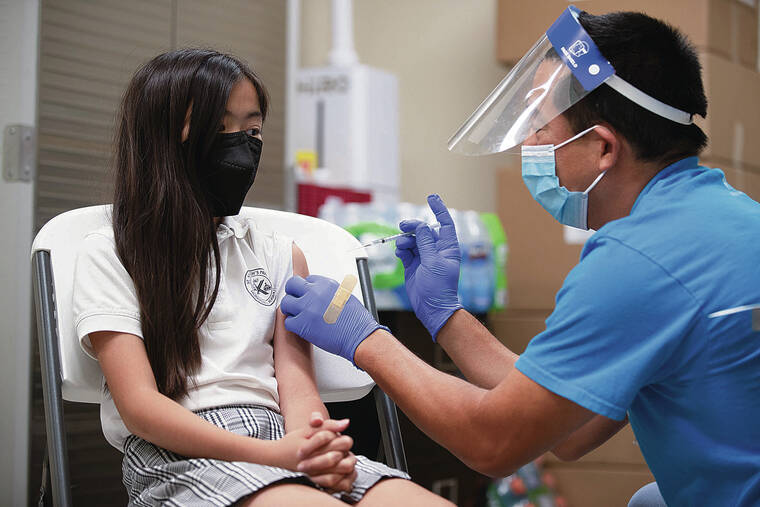
Mahalo for supporting Honolulu Star-Advertiser. Enjoy this free story!
The Hawaii Department of Health on Wednesday reported the state’s seven-day average of new COVID-19 cases at 1,098 over the past week, representing the ninth consecutive weekly increase. If cases are in reality an estimated five to six times higher, then the total of about 5,500 to 6,500 cases has surpassed the peak of the first omicron surge.
The state’s average positivity rate, meanwhile, jumped to 18.3% from 16.9% May 18. It is the 10th week in a row that DOH has recorded an increase in the positivity rate. In Honolulu County, the average positivity rate is now at 20.1%, up from 18.5% last week.
The U.S. Centers for Disease Control and Prevention now ranks Kauai, Honolulu and Maui counties as red, high-risk communities, where masking in public places indoors and on public transportation is recommended. Hawaii County remains a yellow, medium-risk community.
Due to rising infections, the University of Hawaii and Honolulu’s Summer Fun program are once again requiring indoor masking among students and participants in what is now considered a second omicron surge.
County mayors have no plans to reinstate indoor mask mandates, and are encouraging residents instead to take precautions.
Hawaii County Mayor Mitch Roth is urging residents to practice “mindful masking,” while Maui Mayor Mike Victorino urges citizens to carry out “respectful masking.”
“Respectful masking means, please, right now be respectful to the next person especially our elders, our children, those who have health challenges,” said Victorino during a “Spotlight Hawaii” conversation Wednesday. “Let’s start masking up again indoors, especially when you’re with bigger crowds.”
But Victorino said he does not plan to bring back mandates at this time, and that Maui’s hospitals are “not in bad shape.”
While overall hospitalizations continue to rise, they have not reached levels beyond 400, which occurred during the delta surge.
The number of patients with COVID-19 in Hawaii hospitals Wednesday was at 151, according to the state dashboard and Healthcare Association of Hawaii. On May 18 there were 126.
Of the 151 patients, 13 were in intensive care and seven on ventilators, also an increase from last week.
“The good news is that in terms of severity of illness it’s not as severe as some of the prior surges,” said Hilton Raethel, Healthcare Association of Hawaii president and CEO.
Raethel said about 50% of the hospitalizations are “incidentals,” meaning patients were admitted for other illnesses, then tested positive for COVID-19.
“The critical indicator now is our COVID ICUs,” he said. “It is picking up a little bit, but if we go back to the omicron surge, we had over 50 people in our ICU, and if we go back to the delta surge, we got up to 100 ICU patients.”
The more critical concern is the staffing shortage at hospitals and long-term care facilities. Health care workers are also part of the community, he said, and thus, getting infected with COVID.
Hospitals are planning to bring in an additional 100 health care workers from the U.S. mainland over the next few weeks to alleviate the shortage, on top of 200 that are already here. But federal funding will not be available this time, and hospitals will be footing the bill.
Cases and hospitalizations are expected to keep climbing well into mid-June, according to a forecast by the Hawaii Pandemic Applied Modeling Work Group.
DOH, meanwhile, is reminding people how important it is to stay home when sick.
In a newly launched public service announcement, DOH is reminding people what to do if they test positive for COVID-19 since many are now doing so through home test kits.
Anyone who tests positive for COVID-19 should notify close contacts and isolate for at least five full days.
Current CDC guidance says one can go back to work after five full days since symptoms started — or five days since testing positive for those who are asymptomatic. One must be fever-free for at least 24 hours without the use of medication, and other symptoms must be improving.
“If you still have a fever or your symptoms are not improving, you’ve got to stay in isolation until your temperature comes down and you feel better,” said DOH spokesman Brooks Baehr in the PSA.
After leaving isolation, one should wear a well-fitting mask for days six through 10 around others at home and in public. One should also avoid people with weakened immune systems.
CDC does not require a negative antigen test to exit isolation, but says that if one tests positive at the end of the five-day isolation period, then one should isolate until day 10.
Some health experts warn that the five-day exit strategy is flawed and taken much too literally by employers and employees, and that a negative antigen test should be required before ending isolation. None is required by the state.
A CDC study published in February actually found 54% of people still had positive antigen test results between days five and nine after symptom onset or initial diagnosis from COVID-19.
“We have been concerned about this from the day the CDC made this announcement nationwide because that is not following the science,” said Dr. Scott Miscovich of Premier Medical Group. “We know that statistically, approximately 40% of everyone will still be shedding (virus) after day five.”
He added, “The best practice and science supports a negative antigen test before you return to work.”
Close contacts of a COVID-positive case who are asymptomatic should take two antigen tests total — one test five days after exposure followed by another one in 48 hours for improved accuracy. Many people do not know or do this, Miscovich said.
Health experts, meanwhile, say the COVID-19 vaccines are still effective at protecting people from severe illnesses and deaths, but there have been more breakthrough infections due to the more contagious variants.
The New York Times reported some who were previously infected with omicron are getting reinfected with the newer variants a second, and even third or fourth time, within a year.
Miscovich warns that anyone with just the primary series of COVID-19 vaccines has little protection from the variants right now.
“My concern is, as a state and country, we should be standing on rooftops, letting people know if you’ve only had two shots you’re walking around not very well protected,” he said. “You need to find your third shot.”
Nationally, the United States is averaging more than 104,000 new cases per day, while hospital admissions average more than 3,500 a day, according to the CDC COVID Data Tracker.
The omicron subvariant BA.2.12.1, which drove up cases in New York and Massachusetts, now makes up 58% of new coronavirus infections in the U.S.
BA.2.12.1, which is believed to be about 1.3 times more transmissible than BA.2, has been detected in Hawaii through genome sequencing as early as March 21, according to the state’s latest variant report.
DOH on Wednesday also reported 8,924 new COVID-19 infections over the previous week, bringing the total since the start of the pandemic to 274,495 cases.
By island, there were 6,475 new infections reported on Oahu, 1,102 on Hawaii island, 772 on Maui, 443 on Kauai, 18 on Molokai and 11 on Lanai. An additional 103 infections were reported out of state.
There were five more coronavirus-related deaths, bringing the state’s COVID death toll to 1,451.
WHAT TO DO IF YOU TEST POSITIVE FOR COVID-19
>> Stay home for at least five days and isolate from others in your home, ideally in a designated “sick room” with a separate bathroom. Day zero is the first day of symptoms or the date of the positive viral test for asymptomatic people.
>> Wear a well-fitting mask if you must be around others in your home. Avoid contact with other household members and pets.
>> Take steps to improve ventilation at home, if possible.
>> Monitor your symptoms.
ENDING ISOLATION
>> You may end isolation after five full days if you are fever-free for 24 hours without the use of medication and your other symptoms are improving.
>> Continue to wear a well-fitting mask around others at home and in public for five additional days (days six to 10). Avoid people with weakened immune systems until after at least 10 days.
>> Do not go places where you are unable to wear a mask (i.e., restaurants, some gyms) or travel, and avoid eating around others at home and at work until a full 10 days after your first day of symptoms.
More information is available at hawaiicovid19.com (click on Home Isolation & Quarantine Guidance).
Source: CDC/DOH
Source: Star Ads






